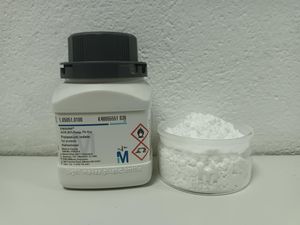Potassium iodate
 Potassium iodate sample and original bottle
| |
| Names | |
|---|---|
| IUPAC name
Potassium iodate
| |
| Other names
Iodic acid, potassium salt
| |
| Properties | |
| KIO3 | |
| Molar mass | 214.001 g/mol |
| Appearance | White solid |
| Odor | Odorless |
| Density | 3.89 g/cm3 (20 °C) |
| Melting point | 560 °C (1,040 °F; 833 K) (decomposition) |
| Boiling point | Decomposes |
| 4.74 g/100 ml (0 °C) 9.16 g/100 ml (25 °C) 32.3 g/100 ml (100 °C) | |
| Solubility | Soluble in aq. KI solution Insoluble in alcohol, liq. ammonia, ethyl acetate, ethylenediamine, hydrazine, conc. nitric acid |
| Vapor pressure | ~0 mmHg |
| Thermochemistry | |
| Std molar
entropy (S |
151.46 J·mol-1·K-1 |
| Std enthalpy of
formation (ΔfH |
-508.4 kJ/mol |
| Hazards | |
| Safety data sheet | Sigma-Aldrich |
| Flash point | Non-flammable |
| Related compounds | |
| Related compounds
|
Potassium chlorate Potassium bromate |
| Except where otherwise noted, data are given for materials in their standard state (at 25 °C [77 °F], 100 kPa). | |
| Infobox references | |
Potassium iodate in an inorganic compound with the formula KIO3.
Contents
[hide]Properties
Chemical
Potassium iodate is an oxidizer, though less powerful than its analogue potassium chlorate.
Heating it at high temperatures will cause it to decompose, releasing oxygen.
- KIO3 → KI + 3/2 O2
Physical
Potassium iodate is a white solid salt, poorly soluble in cold water, but more soluble at high temperatures.
Availability
Potassium iodate is sold by chemical suppliers.
It is more commonly available in pill form, as protection against accumulation of radioactive iodine in the thyroid.
Like potassium bromate, potassium iodate is occasionally used as a maturing agent in baking.
Potassium iodate is sometimes used for iodination of table salt to prevent iodine deficiency.
Preparation
Potassium iodate can be prepared by adding iodine to a hot concentrated solution of potassium hydroxide.[1]
- 3 I2 + 6 KOH → KIO3 + 5 KI + 3 H2O
Since the iodate is much less soluble in cold water than hot water, it will precipitate out of the solution, upon cooling. The yields of this route are not great, however.
Oxidizing potassium iodide with a hot aq. solution of potassium permanganate will yield potassium iodate.[2]
Fusing potassium iodide with potassium chlorate or bromate will also yield potassium iodate. Refluxing a solution of iodine in conc. nitric acid with potassium chlorate will yield potassium iodate, in a better yield.
Neutralizing iodic acid with a potassium base, like hydroxide, carbonate or bicarbonate is a quick way of preparing this compound.
Projects
- Oxidizing agent
- Determination of hydrolyzable tannins in plants
- Protection against radioactive iodine
Handling
Safety
Potassium iodate is an oxidizer. It may be harmful if ingested in large amounts.
Storage
In closed bottles, away from any flammable materials.
Disposal
Can be reduced to potassium iodide using a reducing agent, then the iodide recycled.
References
- Jump up ↑ https://www.youtube.com/watch?v=SNXIY4InWFU
- Jump up ↑ https://www.youtube.com/watch?v=tpWb0j78uGU